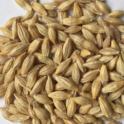DEVELOPMENT

The spring barley ‘UC 969’ is a six-rowed, feed barley which is meant to be sown in the Central Valley and surrounding foothills of California in November or December. UC 969 was released by the California Agricultural Experiment Station in 2001.
BREEDING HISTORY & DEVELOPMENT
The initial parental cross was made by Y.P. Puri, UC Davis barley breeder in 1991. An F4 head row was selected by Lynn Gallagher in 1995, designated UCD 95-2,407 and placed in a preliminary grain yield trial to assess agronomic performance. In 1996 the selection was designated UC 969 and placed into California regional grain yield trials. Heading time for UC 969 was three days earlier than UC 603 and eight days earlier than UC 933 and UC 937 in the first testing period with observations only at Davis. The kernels of UC 969 are hulled and the aleurone is transparent (non-blue). Grains are long (>10mm), slightly wrinkled, and have no hairs on the ventral furrow. Rachilla hairs are long. The appeal of UC 969 is earliness to head and high test weight combined with good but not the highest potential in grain yield. The spike of UC 969 is smooth awned, mid-dense, semi-erect, and heterogeneous for glossy or waxy spikes. Kernel weight for UC 969 averaged 40.7 mg/kernel . Test weight was very high and superior to that observed for UC 603, UC 933 and UC 937. For test weight from 2004 through 2007 over 23 environments, UC 969 averaged 52.2 bu/acre compared to ‘Tamalpais’ aka UC1134 (55.2 bu/ac), ‘Ishi’ aka UC 1047 (49.8 bu/ac), UC 933 (49.6 bu/ac), and UC 937 (49.5 bu/ac).
ADAPTATION
UC 969 is meant to replace UC 603 in environments where early heading is desirable but UC 969 does not have the short, stiff straw which is characteristic of UC 603. UC 969 was taller (35.5 in) than the two semidwarf cultivars; UC 933 (33.1 in) and UC 937 (33.5 in) averaged over 25 location-years in the Central Valley and Central Coast environments. For lodging resistance UC 969 is inferior to UC 603 and similar to or superior to the two above semidwarfs.
PEST & DISEASE RESISTANCE
UC 969 is moderately resistant to Barley yellow dwarf virus, leaf rust, scald, net blotch, and powdery mildew. UC 969 is moderately susceptible to existing pathotypes of stripe rust, but maintains a very high test weight suggesting no loss of grain yield.
YIELD DATA
In 43 grain yield trials from 1997 through 2001, UC 969 averaged 4,436 lb/acre, which was 15.3% more than UC 603 and 12.7% more than UC 937. Remarkably UC 969 averaged 100% of UC 933 for grain yield summed over all environments. Whereas UC 933 and UC 937 are semidwarfs, UC 969 is not a semidwarf but is of intermediate stature with good straw strength. While UC 933 and UC 937 were resistant to stripe rust, UC 969 and UC 603 were both moderately susceptible but escaped grain yield loss because of their earliness to heading and maturity. From 2004 through 2007, UC 969 was compared to more recently developed UC varieties. In 26 environments UC 969 yielded 3,852 lb/acre compared to the following for other varieties: UC 937 (3,958 lb/acre), UC 933 (4,194 lb/acre), UC 1047 ‘Ishi’ (4,328 lb/acre), and UC 1134 ‘Tamalpais’ hulless (4,032 lb/acre). Hence with further testing, UC 933 expressed greater grain yield potential than UC 969 as would be expected given the greater earliness of UC 969.